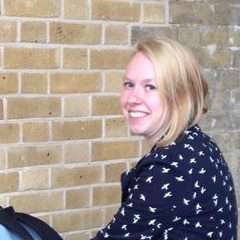The Old Greek word kataklò means ‘I dance by bending and contorting my body’. It is no surprise that a company with such a name is not just any ensemble, but an athletic and theatrical dance group. In February and early March 2014 this Italian company makes a tour around the Netherlands with their show Puzzle. Created by Giulia Stacioli and Jessica Gandini, it includes a combination of both past choreographies and new ones, invented by the seven dancers themselves. The result thereof is a bright palette of different performances in all shapes and sizes.
The programme is divided into two sequences of choreographies that are approximately 5 minutes in duration. These dances contain not just bodily movement, but also acrobatics, mime, and humour. Some of the choreographies are abstract, some tell a story, and others are somewhere in between. All the different choreographies are wrapped in their own distinct coat; each one even more colourful than the last. The few props that are used mainly form vehicles for acrobatic tricks. The bright outfits, paired with the outstanding light effects, form an adequate mise-en-scène and occasionally create stunning visual effects. A prime example of this is Sete from Act II, where the cobalt blue silhouettes of the dancers, created though the colour of their costumes against a light orange back wall, leave an imprint on your retina. Also Suspended dream (Act II) amazes in terms of view and does its title justice; a girl, dressed in white and on a giant swing against a background of leaves, recalls the swing scene from Disney Theatrical’s Tarzan, except this one is more mysterious and fairy-tale-like. The calm singing accompanied by acoustic instruments and drums in the music (Mishaela by Noah) adds to the natural atmosphere. The climax in this choreography lies with the moment where, after a while, the spectator realizes the swing is in fact a second dancer. This creates one of the prettiest and most magical scenes in the sequence. It is no surprise that this choreography, originally from the show Up (2004), returns in Puzzle.
The choreographies contain a mixture of classical, gracious poses, acrobatics and athletics. But, as referred to earlier, the dancers do not ‘just’ move. In some of the dances they use mime to such an extent that the whole becomes a theatrical act. A peak example of this is Quando Volava l’Airone from the first act. This choreography is set to a vintage image that is created by exquisite lighting, which creates the effect of sepia, and two classic bikes. This atmosphere is emphasized by the old-fashioned Italian 1940s record song Voglio Vivere Così by Giovanni D’Anzi, including weathered crackle in the sound. The two male dancers who carry this act stretch their legs as they balance on the bikes, demonstrating their exact control of their trained bodies - as if they were gymnasts. The grace of their moves matches the story that they tell using pantomime in this sweet theatrical choreography.
The absolute climax of the show is the closing choreography from the first act: Bounce. It starts out as a pas de deux reinvented. The man and woman who lead the dance move as one - literally: they scramble over each other and their bodies fit together as a puzzle. The pas de deux soon turns into a fugue-like dance, where one theme is taken over by the other dancers and varied upon. With angular, staccato moves, this choreography is in constant motion and never loses your attention.
These are just a few of the many diverse dances that Puzzle presents. Not only the choreographies, but also the music offerings are versatile. From minimal music to hard rock and even a classic string quartet; it all passes in review. Unfortunately that includes your average Mango store muzak. Though diverse, the music does not always fit and that is unfortunate. Especially in the more acrobatic, spectacular acts, there is a thin line between success and the choreography getting cheesy. Here, the music is a determining factor. The music for Eagle from Act I, Lost Vagueness by Utah Saints, with its hipster beat, synthesizer strings and futuristic sound makes the act come across as a spectacular illusionist show. In Platoon (Act I), the jumpy moves and dancers with clenched fists give the impression of an aerobics class – something that fitting music could have prevented. Unfortunately, the artistic directors decided to opt for the unsettling, hard rock Fly Now by Italo Dorigatti.
Fortunately, most of the choreographies are strong enough to make you forget the occasional poor choice of music. Overall, Puzzle is a sequence of dances so varied that it is sure to satisfy each and every guest and a true feast for the eyes.


